Paracimexomys is a genus of extinct mammals in the also extinct Multituberculata order. Paracimexomys lived during the Cretaceous period. The few fossils remains come from North America. Some Romanian fossils were also tentatively assigned to this genus, though that classification now seems doubtful.
Cimolodon is a genus of the extinct mammal order of Multituberculata within the suborder Cimolodonta and the family Cimolodontidae. Specimens are known from the Late Cretaceous of North America.

Repenomamus is a genus of opossum-sized to badger-sized gobiconodontid mammal containing two species, Repenomamus robustus and Repenomamus giganticus. Both species are known from fossils found in China that date to the early Cretaceous period, about 125-123.2 million years ago. R. robustus is one of several Mesozoic mammals for which there is good evidence that it fed on vertebrates, including dinosaurs, though it is not possible to determine if it actively hunted live dinosaurs or scavenged dead ones. R. giganticus is among the largest mammals known from the Mesozoic era.
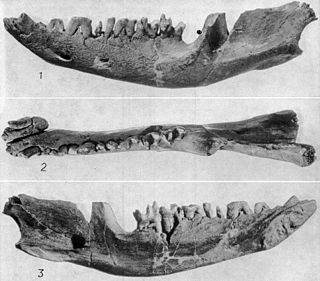
Eodelphis, from eo- plus [Di]delphis, thus meaning "very early opossum", is a genus of stagodont metatherians from the Late Cretaceous of North America, with distinctive crushing dentition. Named species include E. browni and the more advanced E. cutleri. Both come from the Late Campanian of Dinosaur Provincial Park, Alberta. Specimens are also known from the Judith River Formation of Montana. E. cutleri is related to the Maastrichtian genus Didelphodon as indicated by its enlarged premolars and more robust jaw. Eodelphis was probably an aquatic predator like its relative Didelphodon, and may have weighed about 0.6 kg (1.3 lb), making it one of the largest mammals of its time.

Alphadon was a genus of small, primitive mammal that was a member of the metatherians, a group of mammals that includes modern-day marsupials. Its fossils were first discovered and named by George Gaylord Simpson in 1929.
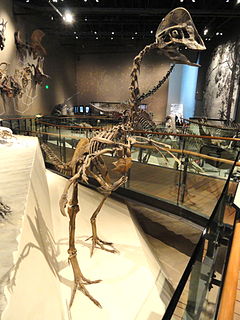
Hagryphus, is an oviraptorosaurian theropod dinosaur from the Upper Cretaceous Period of what is now Utah.
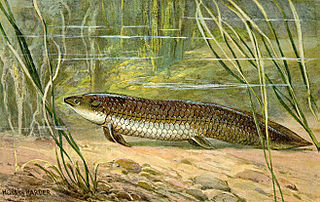
Ceratodus was a wide-ranging genus of extinct lungfish. Fossil evidence dates back to the Early Triassic. A wide range of fossil species from different time periods have been found around the world in places such as the United States, Argentina, Greenland, England, Germany, Egypt, Madagascar, China, and Australia. Ceratodus is believed to have become extinct sometime around the beginning of the Eocene Epoch. The closest living relative of Ceratodus is thought to be the Queensland lungfish, Neoceratodus forsteri, which means "new Ceratodus" in Greek.

The Bearpaw Formation, also called the Bearpaw Shale, is a geologic formation of Late Cretaceous (Campanian) age. It outcrops in the U.S. state of Montana, as well as the Canadian provinces of Alberta and Saskatchewan, and was named for the Bear Paw Mountains in Montana. It includes a wide range of marine fossils, as well as the remains of a few dinosaurs. It is known for its fossil ammonites, some of which are mined in Alberta to produce the organic gemstone ammolite.
The Kaiparowits Formation is a sedimentary rock formation found in the Kaiparowits Plateau in Grand Staircase-Escalante National Monument, in the southern part of Utah in the western United States. It is over 2800 feet thick, and is Campanian in age. This Upper Cretaceous formation was formed from alluvial floodplains of large rivers in coastal southern Laramidia; sandstone beds are the deposit of rivers, and mudstone beds represent floodplain deposits. It is fossiliferous, with most specimens from the lower half of the formation, but exploration is only comparatively recent, with most work being done since 1982. It has been estimated that less than 10% of the Kaiparowits formation has been explored for fossils. Most fieldwork has been conducted by The Natural History Museum of Utah.
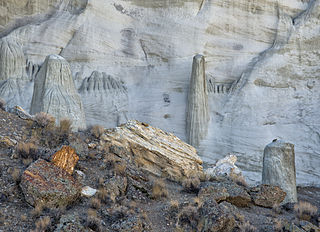
The Wahweap Formation of the Grand Staircase-Escalante National Monument is a geological formation in southern Utah and northern Arizona, around the Lake Powell region, whose strata date back to the Late Cretaceous. Dinosaur remains are among the fossils that have been recovered from the formation.

Diabloceratops is an extinct genus of centrosaurine ceratopsian dinosaur that lived approximately 79.9 million years ago during the latter part of the Cretaceous Period in what is now Utah, in the United States. Diabloceratops was a medium-sized, moderately built, ground-dwelling, quadrupedal herbivore, that could grow up to an estimated 5.5 m (18.0 ft) long. At the time of its discovery, it was the oldest-known ceratopsid, and first centrosaurine known from latitudes south of the U.S. state of Montana. The generic name Diabloceratops means "devil-horned face," coming from Diablo, Spanish for "devil," and ceratops, Latinized Greek for "horned face." The specific name honors Jeffrey Eaton, a paleontologist at Weber State University and long time friend of the lead author Jim Kirkland. Eaton had a big role in establishing the Grand Staircase-Escalante National Monument where the specimen was found. The type species, Diabloceratops eatoni, was named and described in 2010 by James Ian Kirkland and Donald DeBlieux.
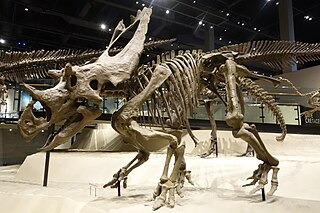
Utahceratops is an extinct genus of ceratopsian dinosaur that lived approximately 76.4~75.5 million years ago during the Late Cretaceous period in what is now Utah. Utahceratops was a large-sized, robustly-built, ground-dwelling, quadrupedal herbivore, that could grow up to an estimated 7 m (23 ft) long.
Continuoolithus is an oogenus of dinosaur egg found in the late Cretaceous of North America. It is most commonly known from the late Campanian of Alberta and Montana, but specimens have also been found dating to the older Santonian and the younger Maastrichtian. It was laid by an unknown type of theropod. These small eggs are similar to the eggs of oviraptorid dinosaurs, but have a distinctive type of ornamentation.

Teratophoneus is a genus of tyrannosaurid dinosaur which lived during the late Cretaceous period in what is now Utah, United States, containing a single known species, T. curriei. It is known from an incomplete skull and postcranial skeleton recovered from the Kaiparowits Formation. It was specifically named T. curriei in honor of Philip J. Currie.

Acristavus is a genus of saurolophine dinosaur. Fossils have been found from the Campanian Two Medicine Formation in Montana and Wahweap Formation in Utah, United States. The type species A. gagslarsoni was named in 2011. Unlike nearly all hadrosaurids except Edmontosaurus, Acristavus lacked ornamentation on its skull. The discovery of Acristavus is paleontologically significant because it supports the position that the ancestor of all hadrosaurids did not possess cranial ornamentation, and that ornamentation was an adaptation that later arose interdependently in the subfamilies Saurolophinae and Lambeosaurinae. It is closely related to Brachylophosaurus and Maiasaura, and was assigned to a new clade called Brachylophosaurini.
Talos is an extinct genus of carnivorous bird-like theropod dinosaur, an advanced troodontid which lived during the late Cretaceous period in the geographic area that is now Utah, United States.
Odaxosaurus is an extinct genus of anguid lizards that existed in western North America from the Late Cretaceous to the Paleocene. Fossils of the type species Odaxosaurus piger and the species O. priscus are widespread throughout Late Cretaceous formations in the western United States and Canada. First described in 1928 from the Lance Formation in Wyoming, O. piger has since been found in the Hell Creek Formation in Wyoming and Montana, the Frenchman and Scollard formations in Alberta, and the Aguja Formation in Texas. It was one of the few species of lizards to survive the Cretaceous–Paleogene extinction event, which is estimated to have killed off 83% of all lizard species. The second species, O. priscus, was named in 1996 from the Dinosaur Park Formation in Alberta and has since been found in the Kaiparowits Formation in southern Utah. Remains of an anguid from the Kirtland Formation in New Mexico may also belong to Odaxosaurus.
Jugulator is a genus of extinct mammal from the Cretaceous of North America. A eutriconodont, it is known from the Cedar Mountain Formation, and is both a large sized and possibly ecologically specialised taxon, showcasing the diversity of mammals in the Mesozoic.

Yehuecauhceratops is a genus of horned centrosaurine ceratopsid dinosaur from the Late Cretaceous of Coahuila, Mexico. It contains a single species, Y. mudei, described from two partial specimens by Rivera-Sylva et al. in 2016 and formally named by Rivera-Sylva et al. in 2017. It was a small centrosaurine with a body length of 3 metres (9.8 ft), making it smaller than Agujaceratops and Coahuilaceratops, the other two ceratopsids in its environment; the three may have been ecologically segregated. A ridge bearing a single roughened projection near the bottom of the squamosal bone, which probably supported a small horn, allows Yehuecauhceratops to be distinguished from other centrosaurines. Its affinities to nasutoceratopsin centrosaurines, such as Avaceratops and Nasutoceratops, are supported by various morphological similarities to the former.
Scalaridelphys is an extinct genus of aquiladelphid pediomyoid mammal from the Late Cretaceous (Turonian)-aged Straight Cliffs Formation of Utah. Initially named as Scalaria in 2020, the genus name was changed to Scalaridelphys in 2021 when the authors were told by B. Creisler that the name Scalaria was already in use for a now obsolete genus of gastropod named by Jean-Baptiste Lamarck in 1801. Two species of Scalaridelphys are known: the type species S. martini and S. aquilana.















